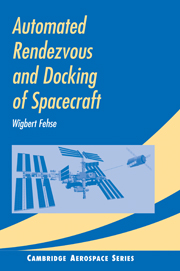Book contents
- Frontmatter
- Contents
- Preface
- List of symbols
- 1 Introduction
- 2 The phases of a rendezvous mission
- 3 Orbit dynamics and trajectory elements
- 4 Approach safety and collision avoidance
- 5 The drivers for the approach strategy
- 6 The onboard rendezvous control system
- 7 Sensors for rendezvous navigation
- 8 Mating systems
- 9 Space and ground system setup
- 10 Verification and validation
- Appendix A Motion dynamics
- Appendix B Rendezvous strategies of existing vehicles
- Appendix C Rendezvous vehicles of the ISS scenario
- Glossary
- References
- Index
Appendix C - Rendezvous vehicles of the ISS scenario
Published online by Cambridge University Press: 13 October 2009
- Frontmatter
- Contents
- Preface
- List of symbols
- 1 Introduction
- 2 The phases of a rendezvous mission
- 3 Orbit dynamics and trajectory elements
- 4 Approach safety and collision avoidance
- 5 The drivers for the approach strategy
- 6 The onboard rendezvous control system
- 7 Sensors for rendezvous navigation
- 8 Mating systems
- 9 Space and ground system setup
- 10 Verification and validation
- Appendix A Motion dynamics
- Appendix B Rendezvous strategies of existing vehicles
- Appendix C Rendezvous vehicles of the ISS scenario
- Glossary
- References
- Index
Summary
The objective of this appendix is to provide an overview of the vehicles which perform rendezvous and capture in the ISS scenario. Of interest are the features of these vehicles which are most important for the implementation of the rendezvous trajectories and for the mating process. These are:
masses and inertias of the vehicles;
actuation means and force/torque capabilities;
location of thrust engines;
features of the vehicle geometry related to rendezvous and capture issues, such as size and shape of main body and appendages;
type and location of mating devices;
type of rendezvous sensors;
It is not the intention to give here a detailed and exhaustive description of all these vehicles, which may anyway undergo changes in the course of their development.
General information on the various vehicles can be obtained from the NASA, NASDA and ESA web-sites. Detailed information on design and history of the Russian vehicles can be obtained from NASAs ‘Mir hardware heritage’ (Portree 1995). Information on all aspects of space stations can be found in Messerschmid & Bertrand (1999). Some information contained in this appendix has been extracted from technical reports and specifications of the International Space Station Programme for the Station and its visiting vehicles (NASA 1999), and some has been obtained by verbal communication from specialists involved in the development of the various spacecraft.
- Type
- Chapter
- Information
- Automated Rendezvous and Docking of Spacecraft , pp. 450 - 469Publisher: Cambridge University PressPrint publication year: 2003



